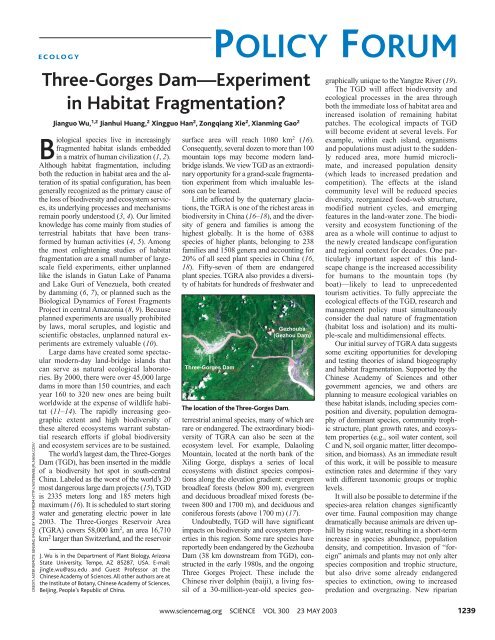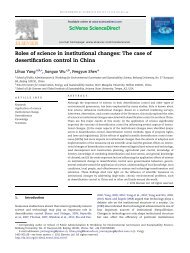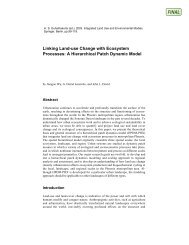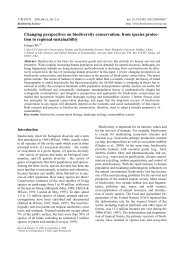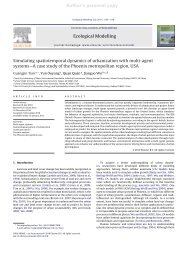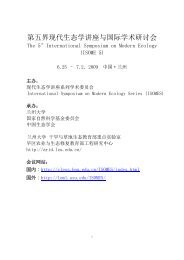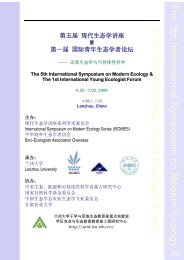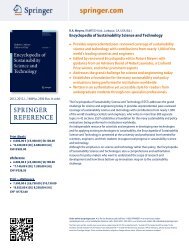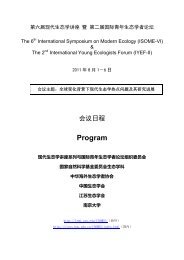Three-Gorges Dam?Experiment in Habitat Fragmentation?
Three-Gorges Dam?Experiment in Habitat Fragmentation?
Three-Gorges Dam?Experiment in Habitat Fragmentation?
Create successful ePaper yourself
Turn your PDF publications into a flip-book with our unique Google optimized e-Paper software.
CREDIT: ASTER REMOTE SENSING IMAGE BY NASA FROM HTTP://ASTERWEB.JPL.NASA.GOV/<br />
ECOLOGY<br />
<strong>Three</strong>-<strong>Gorges</strong> <strong>Dam</strong>—<strong>Experiment</strong><br />
<strong>in</strong> <strong>Habitat</strong> <strong>Fragmentation</strong>?<br />
B iological<br />
Jianguo Wu, 1,2 Jianhui Huang, 2 X<strong>in</strong>gguo Han 2 , Zongqiang Xie 2 ,Xianm<strong>in</strong>g Gao 2<br />
species live <strong>in</strong> <strong>in</strong>creas<strong>in</strong>gly<br />
fragmented habitat islands embedded<br />
<strong>in</strong> a matrix of human civilization (1, 2).<br />
Although habitat fragmentation, <strong>in</strong>clud<strong>in</strong>g<br />
both the reduction <strong>in</strong> habitat area and the alteration<br />
of its spatial configuration, has been<br />
generally recognized as the primary cause of<br />
the loss of biodiversity and ecosystem services,<br />
its underly<strong>in</strong>g processes and mechanisms<br />
rema<strong>in</strong> poorly understood (3, 4). Our limited<br />
knowledge has come ma<strong>in</strong>ly from studies of<br />
terrestrial habitats that have been transformed<br />
by human activities (4, 5). Among<br />
the most enlighten<strong>in</strong>g studies of habitat<br />
fragmentation are a small number of largescale<br />
field experiments, either unplanned<br />
like the islands <strong>in</strong> Gatun Lake of Panama<br />
and Lake Guri of Venezuela, both created<br />
by damm<strong>in</strong>g (6, 7), or planned such as the<br />
Biological Dynamics of Forest Fragments<br />
Project <strong>in</strong> central Amazonia (8, 9). Because<br />
planned experiments are usually prohibited<br />
by laws, moral scruples, and logistic and<br />
scientific obstacles, unplanned natural experiments<br />
are extremely valuable (10).<br />
Large dams have created some spectacular<br />
modern-day land-bridge islands that<br />
can serve as natural ecological laboratories.<br />
By 2000, there were over 45,000 large<br />
dams <strong>in</strong> more than 150 countries, and each<br />
year 160 to 320 new ones are be<strong>in</strong>g built<br />
worldwide at the expense of wildlife habitat<br />
(11–14). The rapidly <strong>in</strong>creas<strong>in</strong>g geographic<br />
extent and high biodiversity of<br />
these altered ecosystems warrant substantial<br />
research efforts if global biodiversity<br />
and ecosystem services are to be susta<strong>in</strong>ed.<br />
The world’s largest dam, the <strong>Three</strong>-<strong>Gorges</strong><br />
<strong>Dam</strong> (TGD), has been <strong>in</strong>serted <strong>in</strong> the middle<br />
of a biodiversity hot spot <strong>in</strong> south-central<br />
Ch<strong>in</strong>a. Labeled as the worst of the world’s 20<br />
most dangerous large dam projects (15), TGD<br />
is 2335 meters long and 185 meters high<br />
maximum (16). It is scheduled to start stor<strong>in</strong>g<br />
water and generat<strong>in</strong>g electric power <strong>in</strong> late<br />
2003. The <strong>Three</strong>-<strong>Gorges</strong> Reservoir Area<br />
(TGRA) covers 58,000 km 2 , an area 16,710<br />
km 2 larger than Switzerland, and the reservoir<br />
J. Wu is <strong>in</strong> the Department of Plant Biology, Arizona<br />
State University, Tempe, AZ 85287, USA. E-mail:<br />
j<strong>in</strong>gle.wu@asu.edu and Guest Professor at the<br />
Ch<strong>in</strong>ese Academy of Sciences. All other authors are at<br />
the Institute of Botany, Ch<strong>in</strong>ese Academy of Sciences,<br />
Beij<strong>in</strong>g, People’s Republic of Ch<strong>in</strong>a.<br />
surface area will reach 1080 km 2 (16).<br />
Consequently, several dozen to more than 100<br />
mounta<strong>in</strong> tops may become modern landbridge<br />
islands. We view TGD as an extraord<strong>in</strong>ary<br />
opportunity for a grand-scale fragmentation<br />
experiment from which <strong>in</strong>valuable lessons<br />
can be learned.<br />
Little affected by the quaternary glaciations,<br />
the TGRA is one of the richest areas <strong>in</strong><br />
biodiversity <strong>in</strong> Ch<strong>in</strong>a (16–18), and the diversity<br />
of genera and families is among the<br />
highest globally. It is the home of 6388<br />
species of higher plants, belong<strong>in</strong>g to 238<br />
families and 1508 genera and account<strong>in</strong>g for<br />
20% of all seed plant species <strong>in</strong> Ch<strong>in</strong>a (16,<br />
18). Fifty-seven of them are endangered<br />
plant species. TGRA also provides a diversity<br />
of habitats for hundreds of freshwater and<br />
<strong>Three</strong>-<strong>Gorges</strong> <strong>Dam</strong><br />
POLICY FORUM<br />
The location of the <strong>Three</strong>-<strong>Gorges</strong> <strong>Dam</strong>.<br />
Gezhouba<br />
(Gezhou <strong>Dam</strong>)<br />
terrestrial animal species, many of which are<br />
rare or endangered. The extraord<strong>in</strong>ary biodiversity<br />
of TGRA can also be seen at the<br />
ecosystem level. For example, Dalaol<strong>in</strong>g<br />
Mounta<strong>in</strong>, located at the north bank of the<br />
Xil<strong>in</strong>g Gorge, displays a series of local<br />
ecosystems with dist<strong>in</strong>ct species compositions<br />
along the elevation gradient: evergreen<br />
broadleaf forests (below 800 m), evergreen<br />
and deciduous broadleaf mixed forests (between<br />
800 and 1700 m), and deciduous and<br />
coniferous forests (above 1700 m) (17).<br />
Undoubtedly, TGD will have significant<br />
impacts on biodiversity and ecosystem properties<br />
<strong>in</strong> this region. Some rare species have<br />
reportedly been endangered by the Gezhouba<br />
<strong>Dam</strong> (38 km downstream from TGD), constructed<br />
<strong>in</strong> the early 1980s, and the ongo<strong>in</strong>g<br />
<strong>Three</strong> <strong>Gorges</strong> Project. These <strong>in</strong>clude the<br />
Ch<strong>in</strong>ese river dolph<strong>in</strong> (baiji), a liv<strong>in</strong>g fossil<br />
of a 30-million-year-old species geo-<br />
www.sciencemag.org SCIENCE VOL 300 23 MAY 2003<br />
graphically unique to the Yangtze River (19).<br />
The TGD will affect biodiversity and<br />
ecological processes <strong>in</strong> the area through<br />
both the immediate loss of habitat area and<br />
<strong>in</strong>creased isolation of rema<strong>in</strong><strong>in</strong>g habitat<br />
patches. The ecological impacts of TGD<br />
will become evident at several levels. For<br />
example, with<strong>in</strong> each island, organisms<br />
and populations must adjust to the suddenly<br />
reduced area, more humid microclimate,<br />
and <strong>in</strong>creased population density<br />
(which leads to <strong>in</strong>creased predation and<br />
competition). The effects at the island<br />
community level will be reduced species<br />
diversity, reorganized food-web structure,<br />
modified nutrient cycles, and emerg<strong>in</strong>g<br />
features <strong>in</strong> the land-water zone. The biodiversity<br />
and ecosystem function<strong>in</strong>g of the<br />
area as a whole will cont<strong>in</strong>ue to adjust to<br />
the newly created landscape configuration<br />
and regional context for decades. One particularly<br />
important aspect of this landscape<br />
change is the <strong>in</strong>creased accessibility<br />
for humans to the mounta<strong>in</strong> tops (by<br />
boat)—likely to lead to unprecedented<br />
tourism activities. To fully appreciate the<br />
ecological effects of the TGD, research and<br />
management policy must simultaneously<br />
consider the dual nature of fragmentation<br />
(habitat loss and isolation) and its multiple-scale<br />
and multidimensional effects.<br />
Our <strong>in</strong>itial survey of TGRA data suggests<br />
some excit<strong>in</strong>g opportunities for develop<strong>in</strong>g<br />
and test<strong>in</strong>g theories of island biogeography<br />
and habitat fragmentation. Supported by the<br />
Ch<strong>in</strong>ese Academy of Sciences and other<br />
government agencies, we and others are<br />
plann<strong>in</strong>g to measure ecological variables on<br />
these habitat islands, <strong>in</strong>clud<strong>in</strong>g species composition<br />
and diversity, population demography<br />
of dom<strong>in</strong>ant species, community trophic<br />
structure, plant growth rates, and ecosystem<br />
properties (e.g., soil water content, soil<br />
C and N, soil organic matter, litter decomposition,<br />
and biomass). As an immediate result<br />
of this work, it will be possible to measure<br />
ext<strong>in</strong>ction rates and determ<strong>in</strong>e if they vary<br />
with different taxonomic groups or trophic<br />
levels.<br />
It will also be possible to determ<strong>in</strong>e if the<br />
species-area relation changes significantly<br />
over time. Faunal composition may change<br />
dramatically because animals are driven uphill<br />
by ris<strong>in</strong>g water, result<strong>in</strong>g <strong>in</strong> a short-term<br />
<strong>in</strong>crease <strong>in</strong> species abundance, population<br />
density, and competition. Invasion of “foreign”<br />
animals and plants may not only alter<br />
species composition and trophic structure,<br />
but also drive some already endangered<br />
species to ext<strong>in</strong>ction, ow<strong>in</strong>g to <strong>in</strong>creased<br />
predation and overgraz<strong>in</strong>g. New riparian<br />
1239
1240<br />
P OLICY F ORUM<br />
communities may develop near the <strong>in</strong>terface<br />
between the “<strong>Three</strong>-<strong>Gorges</strong> Lake” and<br />
the remnant forests, which can significantly<br />
impact the island biotas and the regional<br />
landscape. In addition, changes <strong>in</strong> land-use<br />
patterns due to <strong>in</strong>creased accessibility to<br />
mounta<strong>in</strong> tops, <strong>in</strong> terms of tourism and resettlement<br />
of local people, may have various<br />
impacts on biodiversity. Aside from<br />
island biogeography, other perspectives of<br />
biodiversity and fragmentation, <strong>in</strong>clud<strong>in</strong>g<br />
neutral theory (20), metapopulation theory,<br />
self-organization of biotic communities,<br />
and landscape ecology (1, 21), should be<br />
considered.<br />
Many hypotheses concern<strong>in</strong>g fragmentation<br />
effects and biota relaxation require empirical<br />
data over decades or centuries (7, 8,<br />
22), so it is critical to establish long-term<br />
monitor<strong>in</strong>g programs with permanent field<br />
sites. Meanwhile, rapid biodiversity loss<br />
may occur immediately after “island” formation.<br />
For example, Barro Colorado<br />
Island, the largest island <strong>in</strong> Lake Gatun<br />
formed by damm<strong>in</strong>g the Chagres River <strong>in</strong><br />
1913, lost 45% of its breed<strong>in</strong>g bird species<br />
<strong>in</strong> less than 50 years (7). The study of<br />
Terborgh et al. (6) <strong>in</strong> Lake Guri, created by<br />
damm<strong>in</strong>g <strong>in</strong> 1986, showed that small islands<br />
(


